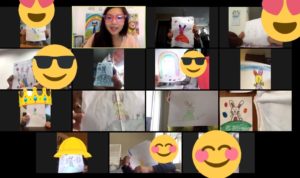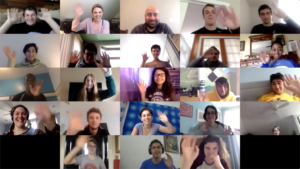Keeping School Special for Children with Learning Differences
How one school has managed to keep the bar high to avoid the COVID-Slide
 It did not take long for us at AIM Academy to recognize in February that, like schools on the west coast, we would eventually face closure as a result of the growing COVID-19 crisis. Being a school exclusively for bright children with learning differences and one committed to the value of personalized learning, we knew our program was not one we could quickly flip onto Google Classroom without significant preparation and meticulous planning. At the time, we had no idea we would ultimately be tasked with keeping our program fully operational online for the remaining three months of school. But, as we approach our sixth week since schools in Pennsylvania shut down, we have managed to keep the bar high, students progressing, parents informed, and teachers well resourced. We think we have learned some lessons worth sharing with others working just as hard to meet the needs of diverse learners right now.
It did not take long for us at AIM Academy to recognize in February that, like schools on the west coast, we would eventually face closure as a result of the growing COVID-19 crisis. Being a school exclusively for bright children with learning differences and one committed to the value of personalized learning, we knew our program was not one we could quickly flip onto Google Classroom without significant preparation and meticulous planning. At the time, we had no idea we would ultimately be tasked with keeping our program fully operational online for the remaining three months of school. But, as we approach our sixth week since schools in Pennsylvania shut down, we have managed to keep the bar high, students progressing, parents informed, and teachers well resourced. We think we have learned some lessons worth sharing with others working just as hard to meet the needs of diverse learners right now.
Learning Disabilities
 High-Incidence Learning Disabilities like Dyslexia, Dysgraphia, and Language Processing Disorders are common. They impact about 1 in 5 school-aged children and represent more than 50% of the children being served by the special education system. While there is a wide range of how those disabilities manifest in children, all children with LDs have a few things in common. They have incredible potential, are talented and sometimes gifted, and when given the right program, they can go on to become very successful adults. However, if given an academic program that is not tailored to their learning profile, many fail to thrive in traditional school, drop out, and experience undesirable outcomes in life ranging from stilted income potential to psychological issues.
High-Incidence Learning Disabilities like Dyslexia, Dysgraphia, and Language Processing Disorders are common. They impact about 1 in 5 school-aged children and represent more than 50% of the children being served by the special education system. While there is a wide range of how those disabilities manifest in children, all children with LDs have a few things in common. They have incredible potential, are talented and sometimes gifted, and when given the right program, they can go on to become very successful adults. However, if given an academic program that is not tailored to their learning profile, many fail to thrive in traditional school, drop out, and experience undesirable outcomes in life ranging from stilted income potential to psychological issues.
Fortunately, there is a great deal of research on how children with LDs learn and what teachers and schools should do to help them reach their potential. Effective academic programs for children with learning differences are carefully tailored and anchored in research. They are explicit, systematic, multi-sensory, and address language and learning skills at a variety of levels. Truly excellent programs for children who struggle in school leave nothing up to chance and every aspect of instruction is individualized and intentional. Therefore, the rapid and en masse move to online learning for children across America last month did not bode particularly well for children with learning or attention challenges.
The Problem
It has been a heavy lift for schools to move their programs online. Even as schools across the country are doing their best to provide positive learning experiences for all students, the task is much harder than it sounds and even more so for those trying to educate children with learning issues. About 95% of American special education students spend at least part of their day included in regular education classes with 60% spending almost the entire day in the regular education setting where class sizes average in the low to mid-20s.
Teachers of those inclusion classes must artfully individualize materials, differentiate text, provide instructions and assignments in multiple formats, and check for understanding often. The most effective classrooms are tactile, involve intentional peer pairings, have very specific programs in place, and are led by nimble and sophisticated educators. This type of individualized attention and specific programming is hard enough to deliver in classes of that size when we are in person. Now put all of those children in a class meeting on Zoom and it becomes quite difficult to individualize materials, instructional techniques, and to find that small group and 1:1 time it takes for children with LDs to avoid COVID Slide.
Parent as Teacher
This new reality obviously presents a challenging dynamic for teachers, schools, and especially for students who already struggle to find their way in school. But let’s think about the role of families for a moment also. The lives of parents and caregivers have been swiftly upended. While many are expected to show up for their own jobs remotely, they are suddenly thrust into the role of proxy teacher for independent work, moderator for live online instruction, and on-call tech support.
For the families of children who need more guidance, assistance, re-teaching, and explicit instruction, this remote learning reality presents a problematic landscape. Parents of learners with specialized needs wisely turn to schools and teachers who have the expertise required to deeply understand how their children learn. Though they may know their children better than anyone, they do not have the training or the skills to be the stand-in teacher when things get tough.
Excellent teachers of children with Learning Differences have had years of training and experience in evidence-based approaches to teaching and theoretical frameworks for learning. Their classroom techniques and instructional moves have also been shaped by the benefit of a lot of trial and error over time. That teacher ‘gut’ helps direct them to know what works best for what kind of learner, for how long, and even at what time of day. Their classroom experience gives them a compass that tells them when to push, when to pivot, when to stop, and how to reframe in the moment. Parents and caregivers just have not had this kind of training or experience. And even if they have, they likely have not with their own child, and certainly not under such unusual circumstances.
Those of us in education know that we have a much easier time teaching other people’s children than we do teaching our own. The relational dynamics of parents and children also make for dangerous terrain when a child experiences frustration, does not understand, or is not yet comfortable with their parents knowing how much help they really need when learning. The problematic landscape parents face is further exacerbated when we think about the role that genetics play in the learning disabilities. Many parents of children who struggle also struggled to develop school skills themselves whether it be in literacy, math, or executive skills. When our kids hit these roadblocks during remote learning and we are the proxy teacher, we may be tasked with assisting in areas that are inherently difficult for us as well.
Doing What Works Online
 As schools began to shut down on the west coast weeks before the pandemic hit Philadelphia, we started preparations. This involved school-wide decisions, tech instruction for faculty, and the demonstration of essential tools for students and parents. It involved a commitment on the part of our admin, staff, and faculty, to get one to two week’s worth of solid plans in the can before schools closed and then a commitment to building more as we moved through those first weeks of the closure.
As schools began to shut down on the west coast weeks before the pandemic hit Philadelphia, we started preparations. This involved school-wide decisions, tech instruction for faculty, and the demonstration of essential tools for students and parents. It involved a commitment on the part of our admin, staff, and faculty, to get one to two week’s worth of solid plans in the can before schools closed and then a commitment to building more as we moved through those first weeks of the closure.
AIM is a 1- 12 school for bright children with learning differences like dyslexia, dysgraphia, and dyscalculia. We are evidence based, arts-based, and deeply committed to each individual child. Therefore, our staff is highly specialized and our program employs a one-size-fits-one approach. We teach in small groups and are flush with technology. Students have 1:1 access to equipment and experience using it. Before this pandemic hit, many of our teachers and students were already facile with most Google Tools, Canvas, and accessing text through Learning Ally or leveraging other tech tools like dictation, Grammarly, or Evernote.
We were positioned well to be prepared for this shut down. However, despite all of the enabling conditions we enjoy as an organization, moving school online was no simple feat. This was not the kind of event where on Friday students went home and on Monday they logged on for full days of remote learning. We have learned some lessons in all of this and the success our students have experienced boils down to a few key items.
- Mission. We are proud to stick closely to our mission at all times. Our mission mandates that we provide extraordinary opportunities for children with LDs through an Arts-based, evidence-based, and college-prep program. Every decision we have made from format of the day, to the tools we would ultimately use, to the actual work in which we would engage children drew us back to our mission. Is this extraordinary? Is this evidence-based? Will this prepare our students for college?
- Technology. Technology is key to successful remote programs.
- Not only do we have excellent technology, but also an incredible tech team. If you do not get the technology right, even the best remote plans will fall apart and you’ll have the kids left behind because they can’t get into the meeting or figure out how to submit the assignments.
- Picking the right tools is essential. For us, a combination of many tools is how we are reaching all of our students, whereas some schools are best served housed entirely on one platform.
- It is important to identify constituents who need tech support. You do this by asking who needs it and offering it to those who might be shy to admit it.
- Teach the technology, teach it again, and keep on teaching it until everyone is not just comfortable, but developing expertise.
- Responsiveness. The most effective special education programs practice rapid responsiveness to the needs of their learners.
- This may be baked into the AIM experience, but it is not something that happens without intentionality. Teachers need to hear that if something is not working, they are free to use their creative license to pivot away and give something else a shot. Naturally, everyone’s bag of tricks must be filled with evidence-based practices from which to choose, but freedom to try and change is important.
- We also practice rapid responsiveness with student, family, or teacher needs – whether it be a tutorial on a tech tool, a 1:1 extra help session, or a clarification on the directions.
- Gathering frequent feedback from students, families, and faculty is important. We are gathering feedback weekly to better understand how our program can be even more responsive to the various needs in our community. Sometimes it is as simple as one question and other times, we are soliciting something more substantial.
- Try Everything. Give every part of your program a shot and don’t settle for anything less than extraordinary.
- Initially it is easy to think, ‘there is no way we can replicate that online’. However, try it and you might be pleasantly surprised to see that while it might not be exactly the same, it is pretty good in the remote format.
- See if you can have live PE classes, live Science labs, and music along with your intensive reading, math, and writing groups. Those enriching parts of school mean so much to kids who have to work twice as hard to learn to read, so try not to gut the whole school experience in an effort to meet your academic priorities.
- Nurture Everyone. Focus on the whole child and while you are at it, focus on the whole teacher too!
- This kind of learning is unusual and not exactly ideal for many of our students. Children need to be nurtured now more than ever. Find ways to connect school counselors to students and families and make a point to connect students to one another by holding social time. We have resumed Clubs, activities, snack and social time daily, and our Middle School is even hosting Movie Nights. Sitting in front of a screen all week is challenging for children, so we have limited-screen time on Wednesdays where teachers send independent work intended to gets kids moving and outdoors where and if possible.
- Teachers are the life-blood of your school and they are bearing the greatest burden. Turning your whole practice on its head like this is hard. Provide ways for teachers to connect, communicate, collaborate, ask for help, get a break, and to laugh. Our schedule is intended to create space just for that with live classes on Monday, Tuesday, Thursday, and Friday while Wednesdays are devoted to teacher planning, collaboration, and progress monitoring. There is also room for fun. One staff member has started faculty game days/nights and of course, there are those Virtual Happy Hours.
- Celebrate Successes. This is important for everyone in the community. Teachers are undertaking a monumental task, families have had their lives turned upside down, and children have lost a lot of the predictability and structure in which they thrive. Yet, there is so much success all around us. Schools need to celebrate the small and big wins that populate the weeks. Most of our all school and social media communication has been about celebrating successes, encouraging families to post their acknowledgement, pride, and gratitude. Celebrating helps keep our tanks full for the next leg of this journey.
- Communication. Frequent, useful, and multi-directional Communication is critical.
- It is a tough balance to strike, but we found that it is helpful to be predictable regarding when families and students should expect to hear new news, when we are updating remote plans from phase I to phase II, or when we are piloting a new tool. We send tactical division level communication every Friday and school-wide communication on Wednesday where we provide high-level updates and ask for feedback.
- Though campus is closed, we continue to leverage communication as a tool for community-wide energy, celebration, and acknowledgement. Communication need not be all tactical just because we are in a crisis. In fact, communication like this is really the only tool you have as a whole school to continue to promote spirit and optimism as we plug along.
- Seek Expertise. There are a lot of voices out there telling us how to teach, what tools to use, and how to navigate the emotional challenges of COVID. It can be hard to know where to go for sound counsel. Look to organizations like Child Mind Institute, National Center for Learning Disabilities, International Dyslexia Association, Decoding Dyslexia, The Dyslexia Foundation, and Understood. The most important variable in a classroom is the knowledge base of the teacher, so connecting faculty to reliable and reputable resources is a vital way to continue moving the needle for your students at this time.
Keeping School Special
In an effort to provide a comprehensive school experience, for our students, the school hours have mostly been preserved. A typical day in the life of a lower school student starts at 8:30 am for live morning circle and that is followed by two essential subjects like intensive small group reading and math. Then there is a prescribed live snack break where the children can catch up and chat and teachers can breathe a little before jumping back into live instruction for more essential subjects like writing and literature. Student days also incorporate specials like Science, History, Phys Ed, Art, Music, or Makerspace.
The program is similarly comprehensive in middle and upper grades where we are holding just about every class on Zoom and the technology has enabled us to assign small-group projects, presentations, and a combination of live teacher led instruction along with collaborative, creative, student-directed, and individual work. All the way through the 12th grade our students continue to pursue passions through the Arts, Music and we are even introducing a COVID-service project as a replacement of an end of year senior internships. Needless to say, school is alive, students are thriving, and our assessment continues so we can be certain that we are delivering on our mission.
We have been so committed to replicating our program in this remote format that we have student clubs meeting, online social activities happening outside of school hours, and our Speech Pathologists, Occupational Therapists, and Executive Function Coaches are providing their services remotely as well. College Counseling continues and even Girls of the Run meets virtually now. We recognized early on that while it was important to replicate small group intensive reading intervention, it was also important to give children time together and to fill the school day with fun and social opportunities.
School at AIM is extraordinary because our staff is too. They are a specifically trained and carefully selected group of innovative educators who thrive in a culture of excellence. With access to incredible resources and top notch professional development, they deliver excellent instruction on a typical school day and so it is not surprising that they are more equipped to deliver excellent instruction remotely. It is more evident now than it has ever been that the most important element in an effective special education classroom is the knowledge base of the teacher leading it.
It is with this deep knowledge that our staff has been able to continue to keep school special in the remote realm. Visual models are important for understanding high level concepts. With that understanding, Mr. Vechick has been able to teach exponential functions in Algebra II using tools like Notebook Software and Wacom Tablets and Bio teacher Mr. Sowers has hosted live feedings of the class snake and students were able to view the hatching of Axolotl eggs. Learning is cemented more easily when it is tied to an experience and that is why 10th grade Honors students held live readings of Sonnet 116 as they prepare to launch into Henry IV with Mr. DiPrinzio while Ms. Rock, Director of our Outride Biking program, had students recording a virtual Biking Safari. It is with the knowledge that multi-sensory learning is how students with language issues acquire content that Ms. Schlosser assembled middle school history students dressed as their favorite muckrakers for an online dinner party and why teaching small group Wilson reading online with all the tactile processes in place is working even for our youngest students.
We have found that while this period of remote school puts students with learning differences at a disadvantage, there are clear and concrete ways schools can work to help bring the best out of these students even while campuses are closed. Although children with learning differences are at the greatest risk of COVID-Slide, we do not need to let the children who need special school experiences the most have anything other than something extraordinary.
Check out these highlight videos on remote learning at the AIM Academy.
ABOUT CHRIS HERMAN
 Christopher F. Herman is Head of School at AIM Academy in Philadelphia where he has been for 14 years. There, he remains devoted to bringing school to life for children with learning differences every day. He is an alumnus of the University of Pennsylvania’s Graduate School of Education and Long Island University. He is an adjunct professor of Education at St. Joseph’s University.
Christopher F. Herman is Head of School at AIM Academy in Philadelphia where he has been for 14 years. There, he remains devoted to bringing school to life for children with learning differences every day. He is an alumnus of the University of Pennsylvania’s Graduate School of Education and Long Island University. He is an adjunct professor of Education at St. Joseph’s University.
